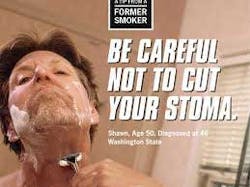Graphic anti-smoking ads increase attempts to quit smoking
This bolsters a study published by researchers at the Perelman School of Medicine at the University of Pennsylvania that showed that the addition of graphic warning labels on cigarette packaging can improve smokers' recall of the warning and health risks associated with smoking.(2)
The Family Smoking Prevention and Control Act gave the U.S. Food and Drug Administration (FDA) legal authority to mandate graphic warning labels on cigarette advertising and packaging.(3) The FDA required that these graphic warning labels be embedded into cigarette advertising and packaging by September 2012.(4) Participants, current daily smokers, were randomized to view a cigarette advertisement with either text-only or graphic warning labels. Viewing patterns were measured using eye-tracking, and recall was later assessed. The conclusion was that graphic warning labels improve smokers’ recall of warning and health risks; these labels do so by drawing and holding attention.Legend: Cigarette advertisement with graphic warning label (a) and text warning label (b). Areas of interest are labeled as whole ad [1]; brand name [2]; cowboy image [3]; graphic image [4]; warning text [5]; Surgeon General’s warning [6]; and FTC text [7].(2)
The new study evaluated the impact of anti-smoking ads run by the New York Tobacco Control Program from 2003 to 2011.(1) Smokers were surveyed about their smoking habits, their recall of anti-smoking ads, their desire to quit and demographic information, such as income level and race.
Researchers looked at media market data and determined that the survey participants were exposed to an average of three emotional or graphic anti-smoking commercials and three comparison ads per month during that period. Comparison ads advocated or encouraged quitting but without strong emotional content.
The survey found that current smokers who recalled seeing at least one emotional or graphic ad were 29 percent more likely to have tried to quit in the prior year. Exposure to comparison ads did not increase quit attempts. If the goal is to get smokers to try to quit, ads need to evoke a strongly negative reaction to smoking. Graphic, emotional ads may work well because they cut through the noise of other advertising.
KEY POINTS
• Smokers who were exposed to graphic or emotional anti-smoking advertisements were more likely to have tried to quit in the past year than smokers who viewed less intense ads.
• Viewing graphic and/or emotional anti-smoking ads were effective at encouraging quit attempts in smokers regardless of previous desire to quit, race or income.
For more information on tobacco cessation, visit the linked websites. (6,7,8)
Tobacco addiction causes 443,000 deaths in the United States each year, making it the leading preventable cause of death. In addition, some 8.6 million Americans live with serious smoking-related illnesses. Of the 45.3 million current smokers, 70% say that they would like to quit. But without assistance, less than 5% are able to stop smoking. They need help from health professionals, whose advice serves as a powerful motivator.(7)
The Smoking Cessation Leadership Center (SCLC) is a national program office of the Robert Wood Johnson Foundation. Significant support is also provided by the American Legacy Foundation. SCLC aims to increase smoking cessation rates and increase the number of health professionals who help smokers quit.
The Center creates partnerships for results with a variety of groups and institutions to develop and implement action plans around smoking cessation. Partnerships with dental hygienists, nurses, pharmacists, emergency physicians, hospitals, labor unions, family physicians, the Veterans Health Administration, and myriad other groups all lead toward the same goal: saving lives by increasing cessation rates and cessation interventions.(7)
Are you asking, advising, and referring?
References 1. Farrelly MC, Duke JC, Davis KC, Nonnemaker JA, Kamyab K, Willett JG, Juster HR. Promotion of Smoking Cessation with Emotional and/or Graphic Antismoking Advertising. Am J Prev Med November 2012, Vol. 43, No. 5 (ahead of print). http://www.ajpmonline.org/webfiles/images/journals/amepre/03-AMEPRE_3534%5B4%5D-stamped.pdf. 2. Strasser AA, Tang KZ, Romer D, Jepson C, Cappella JN. Graphic Warning Labels in Cigarette Advertisements: Recall and Viewing Patterns. American Journal of Preventive Medicine Vol. 43, Issue 1, Pages 41-47. 3. Food and Drug Administration. www.fda.gov/TobaccoProducts/Labeling. 4. Food and Drug Administration. www.fda.gov/TobaccoProducts/Labeling. 5. Graphic Anti-Smoking Ads Increase Attempts to Quit. Newswise Press Release. Released: 10/5/2012 3:50 PM EDT. 6. http://www.smokefree.gov/. 7. http://smokingcessationleadership.ucsf.edu/. 8. http://www.askadviserefer.org/.Maria Perno Goldie, RDH, MS
To read previous RDH eVillage FOCUS articles by Maria Perno Goldie, go to articles.






